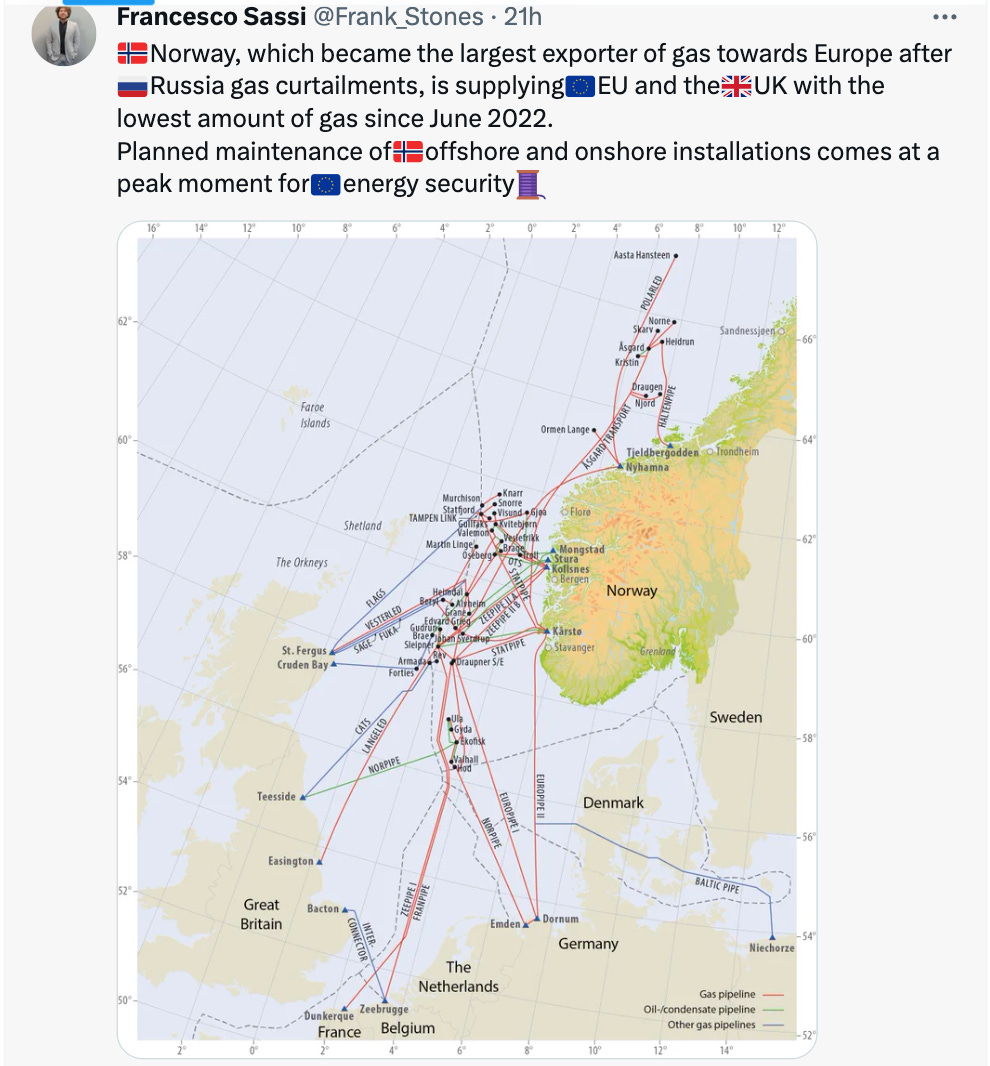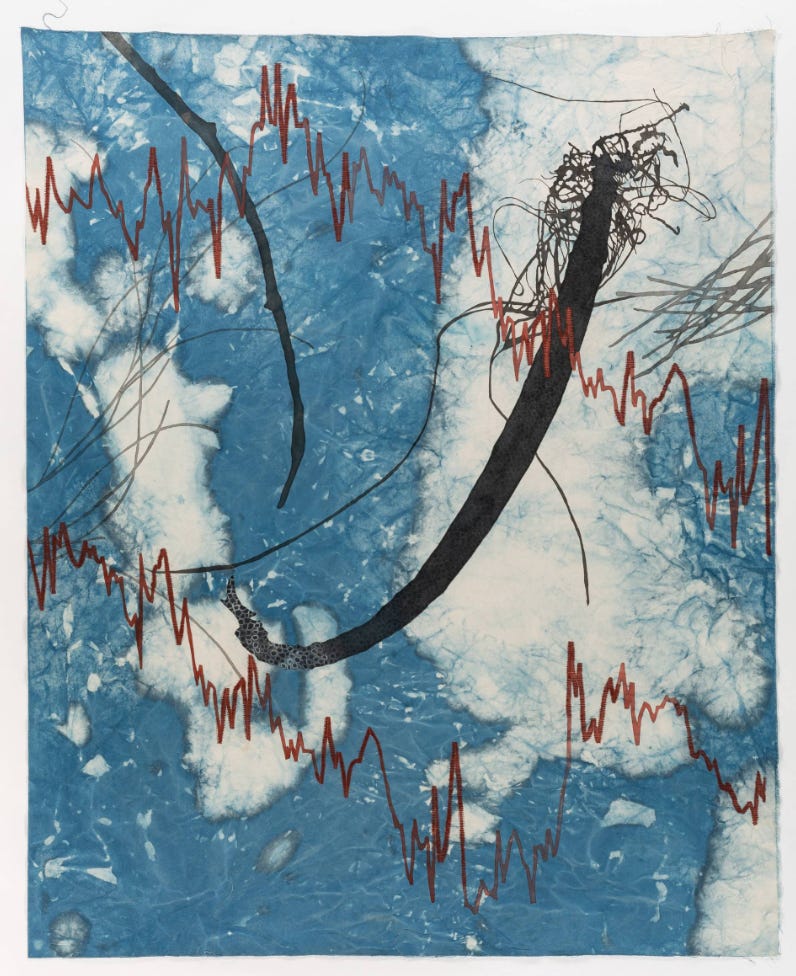Norway's gas network, China's cyber attacks on Japan and why big American cities have not come back.
Great links, reading and images from Chartbook Newsletter
Thank you for reading Chartbook Newsletter.
Judy Watson (1959-), Museum Piece (1998) Source: NSW Art Gallery
I enjoy doing this. But what keeps the newsletter going, are voluntary subscriptions.
Europe’s budget negotiations get real
For subscribers only
You could joint the supporters club and get the full Top Links!
Norway’s gas network
All you have to do is to click the tab below and pick the option that works best for you.
Energy abundance strategy - Yglesias on IRA
But the “cheap stuff is good” philosophy is integral to understanding the climate provisions of IRA, too, because the bill actually represents a conceptual revolution in how to approach climate policy. The original Obama-era idea was carbon pricing — making dirty energy more expensive — which failed in Congress only to be replaced by regulatory strategies like the Clean Power Plan that also aimed to make dirty energy more expensive. During the Trump years, activists and advocates continued to come up with more ways for the next Democratic administration to drive energy costs up. A big part of the push to declare Manchin a bad-faith actor was a sense that the White House was holding off on dramatic executive action in order to appease the West Virginia senator. If activists could convince Biden to give up on Manchin, then they could push him to do everything in his power to throttle fossil fuel production and drive the cost of dirty energy up. But that’s not what happened. Instead, IRA achieves emissions reductions almost entirely by trying to lower the cost of clean energy and electric appliances … and while Biden has certainly done executive actions on environmental issues, we’re also on pace to set an all-time record in American oil production this year. That’s the actual energy policy Democrats ended up enacting — an abundance-oriented approach to the energy transition that focuses on driving costs down.
Red tides, 1997 Judy Watson Source: NSW Art Gallery
Working from home and why America’s big cities are not coming back
For subscribers only.
Why Taiwan matters so much for microelectronics
Physical chips are not particularly scarce at the moment. In fact, for most types of chips, there is a supply glut that is expected to last at least until the end of the year. Recommended Semiconductors China imports record amount of chipmaking equipment The problem currently lies in the final stages of making a chip. Near the end of the manufacturing process, chips are put into a protective case. The connections needed for the chips to be used in an electronic device or a server are then added, in a process called packaging. Here, TSMC has an edge. It has a wide range of patents surrounding advanced chip packaging. Its ability to assemble chips using a high-density packaging technology, where chips are stacked three-dimensionally for higher performance, is what makes chips faster than ever. Chips used for heavy data processing, such as AI, require this advanced packaging technology. But capacity is highly constrained. This entire ecosystem, from chip manufacturing to packaging, is set up in Taiwan, around TSMC. That makes it difficult to move manufacturing outside of Taiwan. Thus, even setting costs aside, building more fabrication plants in other countries is not the solution for companies like Nvidia that require the highest tech chips.
Source: June Yoon for FT
Chinese cyber attacks on Japan
Leo Lewis in Tokyo YESTERDAY 13 Print this page The organisation responsible for Japan’s national defences against cyber attacks has itself been infiltrated by hackers, who may have gained access to sensitive data for as much as nine months. According to three government and private sector sources familiar with the situation, Chinese state-backed hackers were believed to be behind the attack on Japan’s National Center of Incident Readiness and Strategy for Cybersecurity (NISC), which began last autumn and was not detected until June. … This month the Washington Post reported the discovery of a massive attack on Japan’s defence networks by Chinese military hackers carried out in late 2020. In July (2023), an attack that was disguised as a ransomware incident temporarily closed down the port of Nagoya. It has since been assessed by government cyber experts as part of a “persistent testing of Japan’s infrastructural defences by China”. NISC announced in early August that some personal data linked to email exchanges between October last year and June this year may have leaked after its email system was hacked. The breach appeared to have been made via the email account of an individual staff member, NISC said.
Leo Lewis in FT
The report by Ellen Nakashima who broke the story for WaPo is really remarkable also for the light it throws on the attenuated intelligence relationship between Japan and the USA
In the fall of 2020, the National Security Agency made an alarming discovery: Chinese military hackers had compromised classified defense networks of the United States’ most important strategic ally in East Asia. Cyberspies from the People’s Liberation Army had wormed their way into Japan’s most sensitive computer systems. The hackers had deep, persistent access and appeared to be after anything they could get their hands on — plans, capabilities, assessments of military shortcomings, according to three former senior U.S. officials, who were among a dozen current and former U.S. and Japanese officials interviewed, who spoke on the condition of anonymity because of the matter’s sensitivity. “It was bad — shockingly bad,” recalled one former U.S. military official, who was briefed on the event, which has not been previously reported. The 2020 penetration was so disturbing that Gen. Paul Nakasone, the head of the NSA and U.S. Cyber Command, and Matthew Pottinger, who was White House deputy national security adviser at the time, raced to Tokyo. They briefed the defense minister, who was so concerned that he arranged for them to alert the prime minister himself. … By early 2021, the Biden administration had settled in, and cybersecurity and defense officials realized the problem had festered. The Chinese were still in Tokyo’s networks. Since then, under American scrutiny, the Japanese have announced they are ramping up network security, boosting the cybersecurity budget tenfold over the next five years and increasing their military cybersecurity force fourfold to 4,000 people.
Judy Watson, Memory scar, grevillea, mangrove pod (& net), 2020 Source: MCA
If you have scrolled this far, you know you want to click








